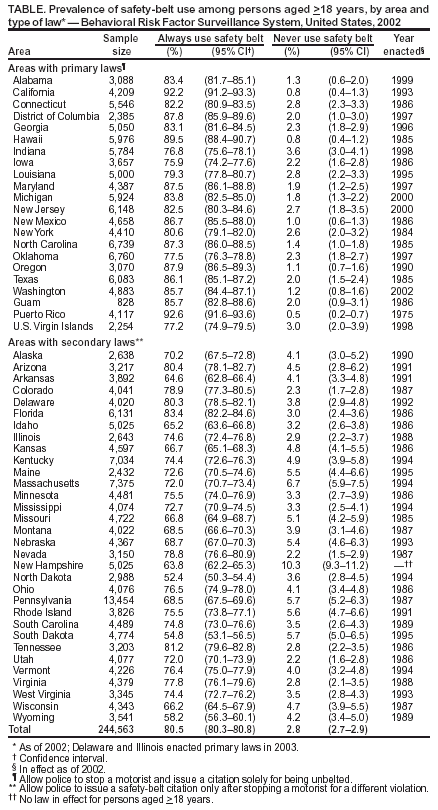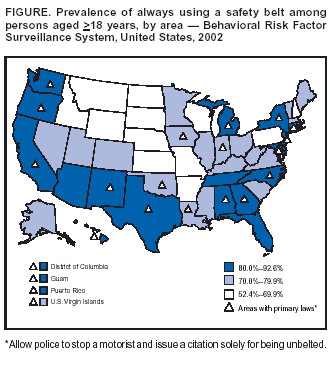 |
|
|
|
|
|
|
| ||||||||||
|
|
|
|
|
|
|
||||
| ||||||||||
|
|
|
|
|
Persons using assistive technology might not be able to fully access information in this file. For assistance, please send e-mail to: mmwrq@cdc.gov. Type 508 Accommodation and the title of the report in the subject line of e-mail. Impact of Primary Laws on Adult Use of Safety Belts --- United States, 2002Motor-vehicle crashes are the leading cause of death among persons aged 1--34 years in the United States (1). Safety belts are the single most effective means of reducing crash-related deaths (2). State laws have had a critical role in increasing belt use. As of December 2003, the District of Columbia (DC), 20 states, and three U.S. territories* had primary laws (i.e., primary enforcement safety-belt laws), which allow police to stop a motorist and issue a citation solely for being unbelted. Another 29 states had secondary laws, which allow police to issue a safety-belt citation only after stopping a motorist for a different violation. Primary laws are more effective than secondary laws for increasing safety-belt use and reducing traffic fatalities (3). To assess safety-belt use among U.S. states and territories with and without primary laws, CDC analyzed data from the 2002 Behavioral Risk Factor Surveillance System (BRFSS) survey. This report summarizes the results of that analysis, which indicated that the prevalence of self-reported safety-belt use was higher among states with primary laws (85.3%) than among states with secondary laws (74.4%). To reduce deaths from motor-vehicle crashes, states should consider enactment of primary laws. In 2002, all 50 states, DC, Guam, Puerto Rico, and the U.S. Virgin Islands (USVI) participated in BRFSS, a state-based, random-digit--dialed telephone survey of the noninstitutionalized, civilian U.S. population aged >18 years. Prevalence estimates were weighted to represent the state and territorial populations. SUDAAN was used to account for the complex sampling design. Safety-belt use was estimated on the basis of responses to the following question: "How often do you use safety belts when you drive or ride in a car?" Response options were "always," "nearly always," "sometimes," "seldom," "never wear a belt," or "never drive or ride in cars." Respondents who never drove or rode in cars, refused to respond, or responded "don't know" (n = 807) were excluded from all analyses. Sample size for this study was 244,563; median response rate was 58.6% (range: 42.2%--82.6%). Jurisdictions were identified as having either primary or secondary safety-belt laws in effect during 2002. Washington enacted a primary law in July 2002 and was classified as a primary-law state for analysis; New Hampshire has no safety-belt law that applies to persons aged >18 years but was classified as a secondary-law state for analysis. Among the 50 states and DC, prevalence of always using a safety belt ranged from 52.4% in North Dakota to 92.2% in California (Table). Safety-belt use was higher in states with primary laws (85.3%; 95% confidence interval [CI] = 84.9%--85.7%) than in states with secondary laws (74.4%; 95% CI = 74.1%--74.8%). In addition, the prevalence of never using a safety belt among states with secondary laws (4.1%; 95% CI = 3.9%--4.3%) was more than double the prevalence among states with primary laws (1.8%; 95% CI = 1.7%--2.0%). Among territories, the prevalence of always using safety belts was 85.7% in Guam, 92.6% in Puerto Rico, and 77.2% in USVI (Table). A total of 18 states, DC, and the three territories had primary laws during the study period; 17 of these 22 jurisdictions reported safety-belt use of >80% (Figure). All 12 states with <70% belt use had secondary laws. Reported by: LF Beck, MPH, KA Mack, PhD, RA Shults, PhD, Div of Unintentional Injury Prevention, National Center for Injury Prevention and Control, CDC. Editorial Note:Increasing the use of safety belts could substantially reduce deaths from motor-vehicle crashes in the United States, where safety-belt use ranks among the lowest of high-income countries (i.e., countries with annual gross national product of >$9,206 per capita) (4). Residents of states with secondary laws were less likely to use safety belts than residents of states with primary laws, a finding supported by observational studies (i.e., studies in which belt use is observed directly by an independent data collector) (5). In contrast to BRFSS, observational studies provide information about safety-belt use for a single occasion and for drivers and front-seat passengers only. In 2002, the prevalence of observed safety-belt use was 69% in states with secondary laws and 80% in states with primary laws (5). The findings in this report are subject to at least three limitations. First, BRFSS excludes households without telephones; however, because only an estimated 2.4% of U.S. homes are without telephones, this limitation should have minimal impact on the findings. Second, the BRFSS sample is limited to noninstitutionalized, civilian adults and might not be representative of safety-belt use among youths, institutionalized persons, or military personnel. Finally, the data are self-reported, and social-desirability bias might result in overestimates of safety-belt use. In April 1997, the U.S. Department of Transportation recommended that all states enact and actively enforce primary enforcement safety-belt laws (6). Since those recommendations were issued, only eight additional states have enacted primary laws. As of December 2003, a total of 29 states had secondary laws, and one state (New Hampshire) had no law mandating safety-belt use by adults. Perceived public opposition to primary laws is a potential barrier to their implementation. Infringement on personal freedom and the potential for differential enforcement on the basis of race/ethnicity are the concerns voiced most frequently (7). However, a national survey conducted in 2000 indicated that 61% of U.S. residents supported primary laws, with support higher in states with primary laws (70%) than in states with secondary laws (53%) (8). In response to concerns about differential enforcement, certain states have added anti-harassment language to their laws to reduce the potential for discrimination (7); available evidence does not demonstrate problems with differential enforcement (9). On the basis of systematic reviews of published studies, the Task Force on Community Preventive Services issues recommendations on population-based interventions to promote health and prevent disease, injury, disability, and premature death. The Task Force recommends the use of primary laws because of strong evidence demonstrating that they have a greater impact than secondary laws (10). The Task Force also recommends high-visibility enforcement of the laws (e.g., safety-belt checkpoints) to further increase safety-belt use (10). The findings in this report indicate that differences in safety-belt use persist on the basis of the type of law in effect in the state. States should consider primary-enforcement safety-belt laws as an effective strategy to increase safety-belt use and decrease serious injuries and deaths associated with motor-vehicle crashes. Acknowledgment This report is based on data contributed by state BRFSS coordinators. References
* Alabama, California, Connecticut, Delaware, Georgia, Hawaii, Illinois, Indiana, Iowa, Louisiana, Maryland, Michigan, New Jersey, New Mexico, New York, North Carolina, Oklahoma, Oregon, Texas, Washington; Guam, Puerto Rico, and U.S. Virgin Islands.
Table  Return to top. Figure  Return to top.
Disclaimer All MMWR HTML versions of articles are electronic conversions from ASCII text into HTML. This conversion may have resulted in character translation or format errors in the HTML version. Users should not rely on this HTML document, but are referred to the electronic PDF version and/or the original MMWR paper copy for the official text, figures, and tables. An original paper copy of this issue can be obtained from the Superintendent of Documents, U.S. Government Printing Office (GPO), Washington, DC 20402-9371; telephone: (202) 512-1800. Contact GPO for current prices. **Questions or messages regarding errors in formatting should be addressed to mmwrq@cdc.gov.Page converted: 4/1/2004 |
|||||||||
This page last reviewed 4/1/2004
|